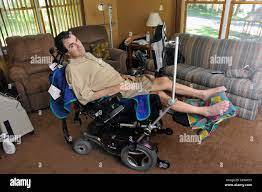Amyotrophic Lateral Sclerosis (ALS): Causes, Symptoms, Treatment, and Future Directions
Introduction
Amyotrophic Lateral Sclerosis (ALS), also known as Lou Gehrig's disease, is a progressive neurodegenerative disorder that affects nerve cells in the brain and the spinal cord. It leads to the deterioration of motor neurons, causing muscle weakness, paralysis, and ultimately, respiratory failure. Despite its relatively low prevalence compared to other neurological disorders, ALS profoundly impacts the lives of patients, caregivers, and families. In this comprehensive guide, we will delve into the intricacies of ALS, including its causes, symptoms, diagnosis, treatment options, and ongoing research efforts aimed at finding a cure.
Understanding ALS: Causes and Risk Factors
While the exact cause of ALS remains unknown, researchers believe that a combination of genetic and environmental factors contributes to its development. Approximately 5-10% of ALS cases are considered familial, meaning they result from inherited genetic mutations. The remaining cases occur sporadically, with no identifiable genetic predisposition. Several genes have been implicated in familial ALS, including C9orf72, SOD1, TARDBP, FUS, and others. These genes play various roles in cell function, protein metabolism, and RNA processing, and mutations in them can disrupt neuronal function and lead to neurodegeneration.
Environmental factors may also play a role in ALS, although their contribution is less clear. Some studies have suggested potential links between ALS and exposure to toxins, heavy metals, pesticides, and traumatic brain injuries. However, further research is needed to establish definitive causative relationships.
Symptoms of ALS
ALS typically manifests with a progressive loss of motor function, characterized by muscle weakness, muscle atrophy, and eventual paralysis. The disease often begins with subtle symptoms, such as weakness or twitching in the limbs, difficulty walking or performing routine tasks, and slurred speech. As it progresses, patients may experience increasing difficulty with movement, including challenges with swallowing, speaking, and breathing.
ALS is classified into two main types based on the pattern of symptoms:
1. Sporadic ALS: This form accounts for the majority of cases and occurs randomly without any known genetic predisposition. It tends to affect individuals between the ages of 40 and 70, although it can occur at any age.
2. Familial ALS: Inherited genetic mutations cause this form of ALS, which typically presents earlier in life, often before the age of 40. Familial ALS tends to progress more rapidly than sporadic ALS.
Diagnosis and Prognosis
Diagnosing ALS can be challenging, as its early symptoms may mimic those of other neurological conditions. Medical professionals typically rely on a combination of clinical evaluations, neurological examinations, electromyography (EMG), nerve conduction studies, and imaging tests to assess muscle function and rule out other possible causes of symptoms.
Unfortunately, there is currently no cure for ALS, and the disease is invariably fatal. Most individuals with ALS survive between 2 to 5 years following diagnosis, although some may live longer, particularly if they receive supportive care and interventions to manage symptoms and complications.
Treatment Options and Management
Although there is no cure for ALS, various treatment strategies can help manage symptoms, improve quality of life, and prolong survival. These may include:
1. Medications: Riluzole and edaravone are two medications approved by the FDA for the treatment of ALS. Riluzole helps to reduce damage to motor neurons by decreasing the release of glutamate, a neurotransmitter involved in cell signaling. Edaravone acts as a free radical scavenger, reducing oxidative stress and potentially slowing disease progression.
2. Physical and Occupational Therapy: Physical and occupational therapists can provide personalized exercise regimens, assistive devices, and adaptive techniques to help patients maintain mobility, independence, and functional abilities for as long as possible.
3. Speech Therapy: Speech therapists can help individuals with ALS improve communication skills, compensate for speech difficulties, and explore alternative communication methods, such as augmentative and alternative communication (AAC) devices.
4. Nutritional Support: Malnutrition and weight loss are common complications of ALS due to difficulties with swallowing and chewing. Dietitians can offer dietary counseling, recommend nutritional supplements, and provide strategies to optimize calorie and nutrient intake.
5. Respiratory Support: As ALS progresses, respiratory muscles weaken, increasing the risk of respiratory failure. Non-invasive ventilation (NIV) devices, such as bilevel positive airway pressure (BiPAP) machines, can help support breathing and improve oxygenation.
6. Palliative Care and Hospice Services: Palliative care focuses on managing symptoms, relieving pain, and addressing the psychosocial and emotional needs of patients and their families. Hospice care provides end-of-life support and comfort measures when curative treatments are no longer pursued.
Ongoing Research and Future Directions
Despite significant advancements in our understanding of ALS, much remains to be learned about its underlying mechanisms and potential therapeutic targets. Researchers are actively investigating various approaches to treat ALS, including:
1. Gene Therapy: Gene editing techniques, such as CRISPR-Cas9, hold promise for correcting genetic mutations associated with familial ALS and restoring normal cellular function.
2. Stem Cell Therapy: Stem cells have the potential to replace damaged motor neurons, regenerate tissues, and modulate the immune response in ALS. Clinical trials are underway to explore the safety and efficacy of stem cell-based therapies in ALS patients.
3. Neuroprotective Strategies: Therapeutic interventions aimed at preserving motor neuron function and preventing neuronal degeneration are being explored, including neurotrophic factors, antioxidants, and anti-inflammatory agents.
4. Biomarker Discovery: Identifying reliable biomarkers of ALS could facilitate earlier diagnosis, monitor disease progression, and assess treatment responses. Biomarker research may lead to the development of more personalized and targeted therapies for ALS patients.
Conclusion
Amyotrophic Lateral Sclerosis (ALS) is a devastating neurological disorder characterized by the progressive degeneration of motor neurons, leading to muscle weakness, paralysis, and respiratory failure. While there is currently no cure for ALS, ongoing research efforts are focused on unraveling its complexities, identifying novel treatment strategies, and ultimately finding a cure. In the meantime, a multidisciplinary approach to ALS management, encompassing medical, rehabilitative, and supportive interventions, can help improve the quality of life for patients and their families living with this challenging disease.


